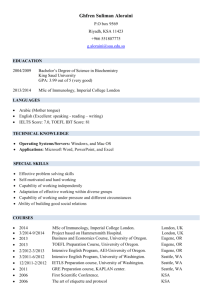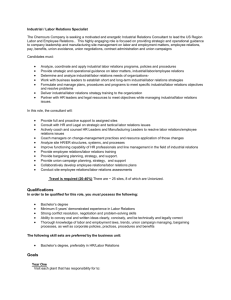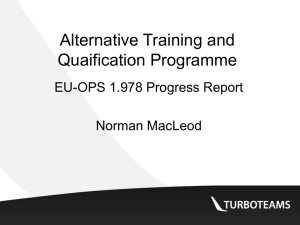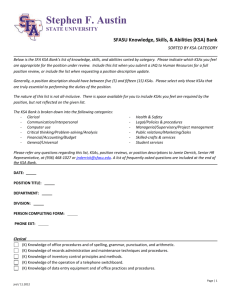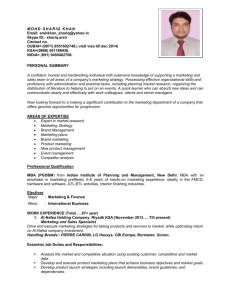CORE COMPETENCIES AND KNOWLEDGE, SKILLS, AND
advertisement
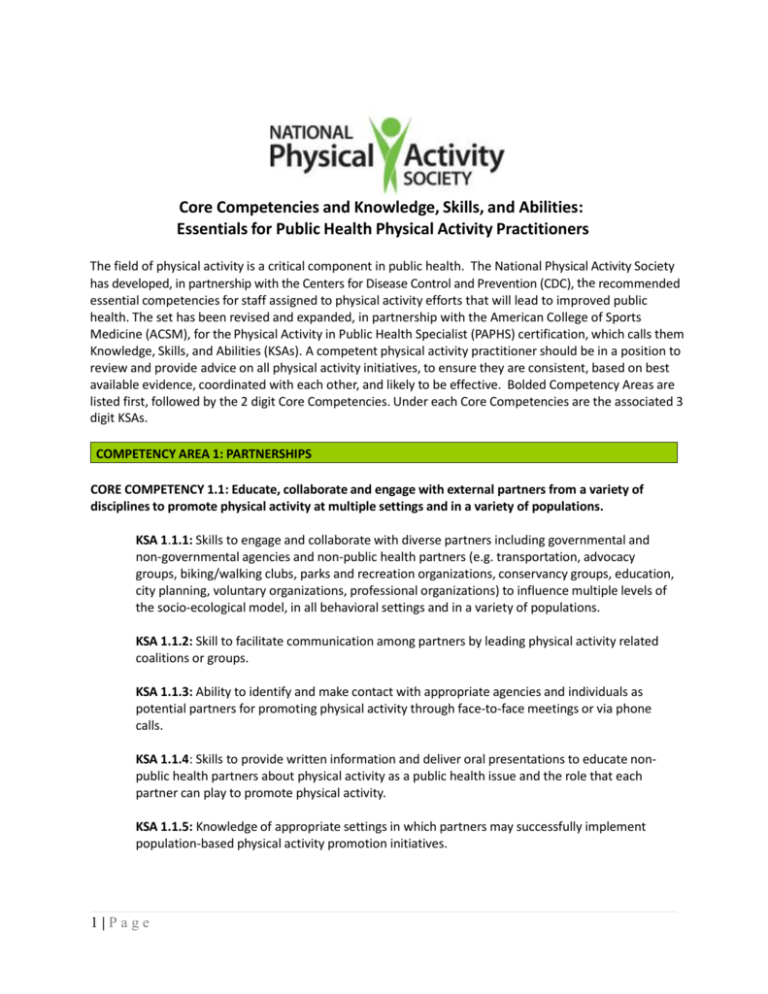
Core Competencies and Knowledge, Skills, and Abilities: Essentials for Public Health Physical Activity Practitioners The field of physical activity is a critical component in public health. The National Physical Activity Society has developed, in partnership with the Centers for Disease Control and Prevention (CDC), the recommended essential competencies for staff assigned to physical activity efforts that will lead to improved public health. The set has been revised and expanded, in partnership with the American College of Sports Medicine (ACSM), for the Physical Activity in Public Health Specialist (PAPHS) certification, which calls them Knowledge, Skills, and Abilities (KSAs). A competent physical activity practitioner should be in a position to review and provide advice on all physical activity initiatives, to ensure they are consistent, based on best available evidence, coordinated with each other, and likely to be effective. Bolded Competency Areas are listed first, followed by the 2 digit Core Competencies. Under each Core Competencies are the associated 3 digit KSAs. COMPETENCY AREA 1: PARTNERSHIPS CORE COMPETENCY 1.1: Educate, collaborate and engage with external partners from a variety of disciplines to promote physical activity at multiple settings and in a variety of populations. KSA 1.1.1: Skills to engage and collaborate with diverse partners including governmental and non-governmental agencies and non-public health partners (e.g. transportation, advocacy groups, biking/walking clubs, parks and recreation organizations, conservancy groups, education, city planning, voluntary organizations, professional organizations) to influence multiple levels of the socio-ecological model, in all behavioral settings and in a variety of populations. KSA 1.1.2: Skill to facilitate communication among partners by leading physical activity related coalitions or groups. KSA 1.1.3: Ability to identify and make contact with appropriate agencies and individuals as potential partners for promoting physical activity through face-to-face meetings or via phone calls. KSA 1.1.4: Skills to provide written information and deliver oral presentations to educate nonpublic health partners about physical activity as a public health issue and the role that each partner can play to promote physical activity. KSA 1.1.5: Knowledge of appropriate settings in which partners may successfully implement population-based physical activity promotion initiatives. 1|Page KSA 1.1.6: Ability to coordinate diverse partners’ efforts to promote physical activity among defined target populations. CORE COMPETENCY 1.2: Work with organizations and individuals to capitalize on complementary strengths, capabilities, resources and opportunities for the promotion of PA. KSA 1.2.1: Ability to identify complementary strengths, goals and resources among partners to coordinate physical activity promotion efforts across organizations. KSA 1.2.2: Ability to recommend partnership activities among organizations based on interests, strengths, capabilities and resources of the organizations. CORE COMPETENCY 1.3: Communicate appropriate public health physical activity messages to intended audiences through a variety of media channels. KSA 1.3.1: Knowledge of how to work with a variety of media (e.g. print, electronic) to create and/or communicate appropriate physical activity information messages to intended audiences. KSA 1.3.2: Ability to work with a variety of media (e.g. print, electronic) to increase exposure to intended audiences of physical activity programs and interventions. KSA 1.3.3: Ability to work with a variety of media to deliver relevant aspects of social marketing campaigns to promote physical activity among intended audiences. CORE COMPETENCY 1.4: Educate partners on the distinction between advocacy and lobbying, and how they can take appropriate action to influence policy change. KSA 1.4.1: Knowledge of the historical and scientific basis of public health policies and practice needed to implement effective physical activity programs. KSA 1.4.2: Skills to educate partners on the historical and scientific basis of public health policies and practice. KSA 1.4.3: Ability to educate partners on the distinction between advocacy and lobbying and to advise partners on appropriate action. COMPETENCY AREA 2: DATA AND SCIENTIFIC INFORMATION CORE COMPETENCY 2.1: Identify and use public health data as a tool to develop and prioritize community-based interventions, including policies, to promote physical activity. KSA 2.1.1: Ability to identify various public health sources of data to justify and support the development of prioritizations of community-base interventions, including policies, to promote PA. KSA 2.1.2: Skill to access and navigate the BRFSS, YRBS, NHANES, and specific state level data sources to justify and support community-based PA interventions, including policies. 2|Page KSA 2.1.3: Ability to translate PA-related data to stakeholders to justify and support communitybased PA interventions, including policies. CORE COMPETENCY 2.2: Maintain professional knowledge of current trends, developments, guidelines, recommendations, and research in the field. KSA 2.2.1: Knowledge of current developing trends to accurately inform the process of interventions, including policy development. KSA 2.2.2: Ability to translate PA guidelines and recommendations to persuade (inform and increase awareness of) stakeholders during the process of intervention, including policy development. KSA 2.2.3: Knowledge of current PA guidelines and recommendations to accurately inform the process of intervention, including policy development. CORE COMPETENCY 2.3: Review and recommend best and evidence-based practices and procedures for the development and implementation of PA promotion efforts. KSA 2.3.1: Ability to review and recommend appropriate practices and procedures for the development and implementation of population based PA programs through formative and process evaluation methods. KSA 2.3.2: Knowledge of evidence-based strategies for promoting PA among specific, identified target audiences to recommend appropriate practices and procedures. KSA 2.3.3: Ability to translate appropriate scientific information and data of evidence-based strategies to recommend PA strategies for the development and implementation of populationbased PA programs. CORE COMPETENCY 2.4: Summarize data to illuminate public health issues in terms of disparity or access as well as other ethical, political, scientific, or economic determinations associated with physical activity. KSA 2.4.1: Ability to summarize data to illuminate ethical, social, political, scientific, economic, and public health issues to identify target audiences for focused interventions, including policies. KSA 2.4.2: Ability to translate data to report ethical, social, political, scientific, economic, and public health issues to stakeholders to justify and support evidence-base PA interventions, including policies. KSA 2.4.3: Knowledge of how scientific information and data illuminates and involves ethical, political, scientific and economic issues related to PA promotion within a public health framework. KSA 2.4.4: Knowledge of protecting confidentiality of information that can harm an individual or community of made public. 3|Page KSA 2.4.5: Ability to improve overall community health in a way that respects the rights of individuals in the community. KSA 2.4.6: Ability to provide communities information needed for decisions on PA policies or programs and obtain communities consent for their implementation. CORE COMPETENCY 2.5: Understand sources of data from professions outside of public health to address program needs (e.g., transportation data). KSA 2.5.1: Ability to understand and interpret sources of data from professions outside of public health to inform program and policy development. KSA 2.5.2: Knowledge of how to identify, understand, and interpret related data from professions outside of public health to justify, support and inform the development and implementation of PA interventions, including policies. KSA 2.5.3: Skill to access and navigate non public health data sources (e.g., FHWA/USDOT, American's Use of Time, US Census, National Park Service, Trust for Public Land, etc.) to inform, justify and support interventions, projects, and policies that promote PA. CORE COMPETENCY 2.6: Use measurement and surveillance mechanisms to assess PA levels across populations. KSA 2.6.1: Ability to navigate measurement and surveillance mechanisms to determine PA levels across populations to develop and prioritize community-based interventions, including policy development. KSA 2.6.2: Knowledge of the strengths and limitations of objectively and subjectively measuring and surveying PA across populations to analyze and determine PA levels. KSA 2.6.3: Skill to implement appropriate measurement and surveillance mechanisms to evaluate PA interventions and policies to determine impact across populations. COMPETENCY AREA 3: PLANNING AND EVALUATING CORE COMPETENCY 3.1: Use theoretical frameworks and models to plan and evaluate physical activity interventions. KSA 3.1.1: Knowledge of at least one evaluation framework, such as CDC’s Framework for Program Evaluation in Public Health for evaluating physical activity interventions KSA 3.1.2: The ability to evaluate physical activity intervention using Theory based frameworks, such as CDC’s Framework for Program Evaluation in Public Health KSA 3.1.3: Knowledge of at least 2 behavioral strategies, such as goal setting or self-monitoring to be considered in planning physical activity interventions 4|Page KSA 3.1.4: The ability to apply behavioral models, such as PRECEDE-PROCEED in physical activity intervention planning CORE COMPETENCY 3.2: Serve as a technical advisor in the design, implementation, and evaluation of physical activity interventions to address chronic disease. KSA 3.2.1: The ability to advise in the design, implementation and evaluation of physical activity interventions associated with chronic disease KSA 3.2.2: Knowledge of design, implementation and evaluation physical activity interventions to address chronic disease CORE COMPETENCY 3.3: Address cultural, social, behavioral, and environmental factors that contribute to disease progression and health promoting behaviors as part of a physical activity program or intervention. KSA 3.3.1: Knowledge of cultural, social and behavioral factors that contribute to chronic disease progression KSA 3.3.2: Knowledge of cultural, social and behavioral factors that affect physical activity promotion KSA 3.3.3 Ability to incorporate a variety of approaches for physical activity programs that anticipate and respect diverse values, beliefs, and cultures in the community CORE COMPETENCY 3.4: Identify internal and external issues, such as changes and trends in financing, regulation, legislation and policies that may impact delivery of public health physical activity services. KSA 3.4.1: Skill to identify internal and external issues in planning physical activity services that impact the delivery of these services KSA 3.4.2: Knowledge of potential internal and external issues that may impact the delivery of public health physical activity services KSA 3.4.3: Knowledge of the how the ten public health essential services are related to the promotion of physical activity CORE COMPETENCY 3.5: Use social marketing principles to target and learn specifically about the population for physical activity intervention. KSA 3.5.1: Knowledge of social marketing principles to assist in planning and evaluating physical activity interventions KSA 3.5.2: Skill to apply social marketing in planning and evaluating physical activity interventions CORE COMPETENCY 3.6: Oversee the development and implementation of a state physical activity plan, which includes goals, SMART objectives and strategies. 5|Page KSA 3.6.1: Knowledge of creating goals, SMART objectives and strategies to develop a population based physical activity plan KSA 3.6.2: Ability to monitor and evaluate a state physical activity plan KSA 3.6.3: Ability to incorporate the socio-ecological model in the development of the state physical activity plan for different settings KSA 3.6.4: Ability to use a multidisciplinary approach and stakeholders in the development of the state physical activity plan CORE COMPETENCY 3.7: Work with key staff to develop an evaluation plan for all physical activity related interventions. KSA 3.7.1: Knowledge of methods to evaluate physical activity intervention strategies that focuses on environmental, policy or individual behavior change CORE COMPETENCY 3.8: Use both quantitative and qualitative analysis to determine process, impact and outcome measures of physical activity programs. KSA 3.8.1: Knowledge of process, impact, and outcome evaluation methods KSA 3.8.2: Skill to analyze and interpret physical activity quantitative and qualitative data to validate conclusions KSA 3.8.3: Ability to produce an evaluation report and disseminate findings to stakeholders and decision makers COMPETENCY AREA 4: INTERVENTIONS CORE COMPETENCY 4.1: Recommend and translate effective intervention strategies to partners and other constituents. KSA 4.1.1: Knowledge of the uses and limitations of the Community Guide to Preventive Services KSA 4.1.2: Knowledge of and ability to apply health promotion theories and planning models KSA 4.1.3: Ability to synthesize evidence base (e.g., scientific information (research) and practical application) to recommend appropriate interventions KSA 4.1.4: Apply research methods and statistical procedures to determine effective intervention strategies KSA 4.1.5: Knowledge of predisposing, enabling and reinforcing factors for physical activity 6|Page CORE COMPETENCY 4.2: Coordinate the efforts of local and community organizations (e.g. worksites, coalitions, agencies, schools, etc.) to create local policy and environmental changes that increase opportunities for physical activity. KSA 4.2.1: Knowledge of and ability to collect quantitative and qualitative data to determine and prioritize health concerns. KSA 4.2.2: Knowledge of information sources for building a rationale for physical activity interventions (needs assessments, epidemiological data, values and benefits important to stakeholders, etc.) KSA 4.2.3: Knowledge of how partnerships facilitate population-based strategies for behavior change KSA 4.2.4: Knowledge of methods to and the ability to leverage networks and collaborative partnerships KSA 4.2.5: Facilitative leadership skills CORE COMPETENCY 4.3: Educate key stakeholders (participants, partners, implementers, and decisionmakers) to influence and effect policy and environmental change. KSA 4.3.1: Knowledge of and ability to produce communication documents KSA 4.3.2: Ability to identify key stakeholders who can influence or effect policy and environmental change KSA 4.3.3: Ability to apply the policy process to influence physical activity policy KSA 4.3.4: Knowledge of how governing bodies such as school boards, local planning boards, state governmental agencies function CORE COMPETENCY 4.4: Understand and communicate the importance of utilizing ecological approaches, and advise on evidence-based strategies to impact each of these levels. KSA 4.4.1: Knowledge of ecological approaches to promote physical activity KSA 4.4.2: Ability to employ strategies to influence different levels of ecological models KSA 4.4.3: Knowledge of measuring impact on different levels of influence on ecological models CORE COMPETENCY 4.5: Understand and communicate theories and mechanisms of policy development and appropriations, including how political and organizational agendas are set and pursued, to impact public health. KSA 4.5.1: Knowledge of policy theories KSA 4.5.2: Ability to set policy agendas for physical activity 7|Page KSA 4.5.3: Knowledge of the legislative process KSA 4.5.4: Knowledge of state and national data to support policy agenda CORE COMPETENCY 4.6: Collaborate with the media to communicate appropriate public health and physical activity messages to intended audiences. KSA 4.6.1: Ability to write press releases KSA 4.6.2: Ability to develop media toolkits KSA 4.6.3: Knowledge of developing appropriate physical activity message for the intended audience KSA 4.6.4: Knowledge of media advocacy COMPETENCY AREA 5: ORGANIZATIONAL STRUCTURE CORE COMPETENCY 5.1: Identify appropriate resources and continuing education for the implementation of a personal professional development plan, which includes training and ongoing technical assistance for promoting physical activity. KSA 5.1.1: Knowledge of training opportunities available in Physical Activity and Public Health KSA 5.1.2: Ability to understand how specific training and technical assistance opportunities address components outlined in a professional development plan CORE COMPETENCY 5.2: Establish partnerships with relevant partners at the federal, state, and local levels and other public and private sectors to promote physical activity as a critical health behavior. KSA 5.2.1 Knowledge of government structure and process KSA 5.2.2: Ability to effectively interact and communicate with multi-level public health professionals and other public partners to promote physical activity KSA 5.2.3: Ability to effectively interact and communicate with the private sector to promote PA KSA 5.2.4: Ability to build partnerships with representatives of public and private organizations and to maintain a professional relationship KSA 5.2.5: Use knowledge of exercise science and public health concepts, principles, risk factors and diseases associated with physical activity and special concerns related to physical activity to elevate physical activity as an essential multidisciplinary component for promoting health. 8|Page CORE COMPETENCY 5.3: Understand the budget management process related to policy and department budgetary processes (e.g., how funding allocations are made), budget appropriations, required budgetary reporting and documentation. KSA 5.3.1: Knowledge of departmental budgetary processes KSA 5.3.2: Skill to effectively manage budget and provide budgetary reports KSA 5.3.3: Ability to understand the legislative budgetary processes and the policy effects of budget appropriations KSA 5.3.4: Ability to maintain accurate records, comprehend and record financial data correctly CORE COMPETENCY 5.4: Demonstrate/Maintain knowledge in the roles of federal, state, and local government and specific legislative processes to address policy changes that impact physical activity. KSA 5.4.1: Knowledge of the legislative process, including the relationship between legislatures, executive agencies, and courts at all levels (local, state, and federal government) as it relates to PA policy. CORE COMPETENCY 5.5: Write and submit grant applications, reports, and manuscripts for professional and other publications, and deliver presentations for programmatic and scientific meetings. KSA 5.5.1: Ability to compile information for professional presentations and publications KSA 5.5.2: Ability to effectively deliver presentations for programmatic and scientific meetings KSA 5.5.3: Ability to write and submit grant applications KSA 5.5.4: Ability to secure funding and resource support through grants and other sources KSA 5.5.5: Ability to define problems, collect data, establish facts and draw valid conclusions KSA 5.5.6: Ability to gather, collate and classify information about data, people or things KSA 5.5.7: Ability to use proper research methods in gathering data KSA 5.5.8: Skills in word processing, spreadsheet, database and presentation software COMPETENCY AREA 6: EXERCISE SCIENCE IN PUBLIC HEALTH SETTING CORE COMPETENCY 6.1: Understand exercise physiology and related exercise science. KSA 6.1.1: Knowledge of anatomy and physiology of the circulatory, respiratory, muscular, and skeletal systems 9|Page KSA 6.1.2: Knowledge of heart rate, blood pressure, and oxygen consumption responses to physical activity KSA 6.1.3: Knowledge of the role of aerobic and anaerobic energy systems as related to the performance of moderate-intensity and vigorous intensity physical activities KSA 6.1.4: Knowledge of the health benefits associated with muscular strength, muscular endurance, balance, flexibility, and body composition (including muscle mass, body fatness, and bone density) KSA 6.1.5: Knowledge of physiological changes that occur through the lifespan and implications for physical activity recommendations CORE COMPETENCY 6.2: Understand health promotion and disease prevention. KSA 6.2.1: Knowledge of the effects of physical activity on promoting general health KSA 6.2.2: Knowledge of the effects of physical activity on primary and secondary prevention of chronic diseases (heart disease, stroke, diabetes mellitus, cancer, arthritis, asthma, osteoporosis, obesity) KSA 6.2.3: Knowledge of the effects of physical activity on reducing chronic disease risk factors (hypertension, dyslipidemia, triglycerides, insulin sensitivity, body fatness) KSA 6.2.4: Knowledge of the effects of physical activity to treat chronic diseases (heart disease, stroke, diabetes mellitus, cancer, arthritis, asthma, osteoporosis, obesity) CORE COMPETENCY 6.3: Understand physical activity assessments. KSA 6.3.1: Knowledge of and ability to utilize assessment tools to determine physical, social, cultural, and environmental supports and barriers to physical activity KSA 6.3.2: Skill in assessment of physical activity at the population level utilizing tools and techniques such as pedometers, accelerometer, surveys, and diaries KSA 6.3.3: Ability to utilize assessment tools to determine individuals’ readiness for change in adopting physical activity behaviors KSA 6.3.4: Knowledge of the physical activity readiness questionnaire (PAR-Q) KSA 6.3.5: Knowledge of various methods for establishing and monitoring levels of physical activity intensity including heart rate, rating of perceived exertion (RPE), and metabolic equivalent (METs) KSA 6.3.6: Knowledge of and ability to analyze and interpret information obtained from physical activity assessments for determining the major components of physical fitness to include flexibility, cardiorespiratory fitness, muscular strength, muscular endurance, and body composition 10 | P a g e KSA 6.3.7: Knowledge of the advantages, disadvantages and limitations of various body composition assessment techniques available in non-clinical settings including but not limited to air displacement plethysmography (“BOD POD,” dual energy x-ray absorptiometry (DEXA), bioelectrical impedance, skinfolds, waist circumference, and body mass index CORE COMPETENCY 6.4: Understand physical activity recommendations and programming. KSA 6.4.1: Knowledge of and ability to describe physical activity recommendations required for health benefits and fitness development KSA 6.4.2: Knowledge of and ability to describe the four domains of physical activity: activities of daily living, active transportation, recreation or leisure activities, and occupational activities KSA 6.4.3: Knowledge of benefits and considerations associated with physical activity across the lifespan for apparently healthy people, people with controlled chronic disease (e.g., heart disease, diabetes mellitus, obesity, hypertension), musculoskeletal limitations (including fatigue), pregnancy and/or postpartum, and exercise-induced asthma KSA 6.4.4: Ability to select or modify physical activity programs that are appropriate to meet the needs of a specific community or population KSA 6.4.5: Knowledge of and ability to describe the benefits, limitations, and safety precautions of various physical activity equipment such as treadmills, stair climbers, elliptical trainers, bicycles, inline skates, stability balls, and hand weights CORE COMPETENCY 6.5: Understand caloric balance and weight management related to physical activity. KSA 6.5.1: Knowledge of the role of carbohydrates, fats, proteins, and alcohol in weight management and the number of kilocalories in one gram of carbohydrate, fat, protein, and alcohol KSA 6.5.2: Knowledge of the following terms: obesity, overweight, percent body fat, body mass index (BMI), waist-to-hip ratio, lean body mass, metabolic syndrome and body fat distribution KSA 6.5.3: Knowledge of the relationship between body composition and health at the various BMI classifications KSA 6.5.4: Knowledge of the relationship between diet, physical activity and behavior modification as methods for modifying body composition KSA 6.5.5: Knowledge of the national nutrition recommendations such as the USDA Food Guide Pyramid and the U.S. Dietary Guidelines KSA 6.5.6: Knowledge of the myths and consequences associated with inappropriate weight loss methods (e.g. fad diets, dietary supplements, excessive physical activity, starvation diets) 11 | P a g e
